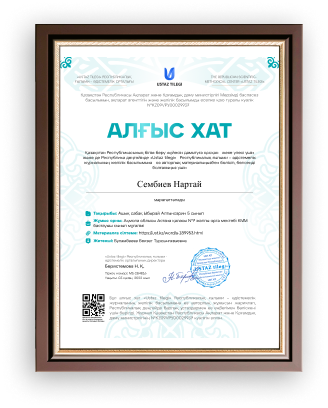
«Д.ҚОНАЕВ АТЫНДАҒЫ АГРАРЛЫҚ ТЕХНИКАЛЫҚ КОЛЛЕДЖІ» МКҚК
Сабақ жоспары №
|
"Module/Subject Title". |
English language |
||||
|
"Lesson Title". |
Floor materials |
||||
|
Prepared by |
|
||||
|
Course |
|
||||
|
Groups: |
|
|
|
|
|
|
Date of the lesson |
|
|
|
|
|
|
Type of the lesson: |
Laboratory |
||||
|
"Lesson aim, objectives, or learning outcomes".
|
Reading and understanding authentic texts of various functional styles related to future professional activity: scientific-public, journalistic, biographical. Болашақ кәсіби қызметпен байланысты әр түрлі функционалды стильдердің: ғылыми-көпшілік, публицистикалық, өмірбаяндық шынайы мәтіндерін оқу және түсіну |
||||
|
"Expected learning outcomes and a list of professional skills to be acquired by students during the course". |
Defines specific information and main points of the topic. Нақты ақпаратты және тақырыптың негізгі тұстарын анықтайды. |
||||
|
Educational and methodological materials, literature |
|
||||
|
Technical tools, materials". |
Interactive whiteboard, computer, reagents: Video, slide |
||||
|
Lesson procedure |
|||||
|
Stages of the lesson |
|
||||
|
1 Organization moment 5minuts |
Greet the students; Take attendance; Check the students' readiness for the lesson; Attract the students' attention to the lesson (introduction activity). |
||||
|
2 Preparation of students for work at the main stage (15minuts) |
Watch the video and tell your opinions
Purpose: Activate prior knowledge and set the context for the lesson.
|
||||
|
3. Approval of new knowledge and methods of activity. (45 минут) |
1. Hardwood 2. Laminate 3. Tile 4. Carpet 5. Vinyl 6. Durability 7. Maintenance 8. Insulation 9. Cost-effective 10. Eco-friendly Flooring is the general term for a permanent covering of a floor, or for the work of installing such a floor covering. Floor covering is a term to generically describe any finish material applied over a floor structure to provide a walking surface. Both terms are used interchangeably but floor covering refers more to loose-laid materials. Materials almost always classified as flooring include carpet, laminate, tile, and vinyl. Subfloor[edit] Main article: Subfloor The floor under the flooring is called the subfloor, which provides the support for the flooring. Special purpose subfloors like floating floors, raised floors or sprung floors may be laid upon another underlying subfloor which provides the structural strength. Subfloors that are below grade (underground) or ground level floors in buildings without basements typically have a concrete subfloor. Subfloors above grade (above ground) typically have a plywood subfloor. [citation needed] Flooring materials[edit] The choice of materials for floor covering is affected by factors such as cost, endurance, noise insulation, comfort, and cleaning effort. Some types of flooring must not be installed below grade, including laminate and hardwood due to potential damage from moisture. The sub-floor may be finished in a way that makes it usable without any extra work, see:
Carpeting[edit] Carpet is a soft floor covering made of bound carpet fibers or stapled fibers. Carpeting refers to wall-to-wall coverage, whereas a rug is simply used to cover a space. This type of flooring is typically used indoors and can be used in both high and low-traffic areas. It typically lasts for 15–18 years before it needs to be replaced. The quality of a carpet is usually measured in face weight, or how many fibers there are per square inch. The higher the face weight the more plush a carpet will feel.[3]
|
||||
|
4 Pre reading activity (15 minuts ) |
Match the words with their definitions.
A. ________ A type of soft floor covering made
from fabric. Part 2: Skimming TaskRead the text quickly and answer the following questions: Text: Choosing the Right Floor Material (Provided by teacher in lesson)
Part 3: Scanning TaskFind specific details in the text to answer these questions:
Part 4: True/False StatementsWrite True (T) or False (F) for each statement based on the text:
|
||||
|
5 To give information about hometask (2 minuts ) |
VOCABULARY EXTENSION: Choose several of the words from the text. Use Google’s search field (or another search engine) to build up more associations / collocations of each word. |
||||
|
6. Summarizing the lesson and reflection (8 minuts ) |
Answer any questions from students regarding the topic that they did not understand. Ask several questions to clarify the students' understanding of the topic and gather feedback from them. |
||||
Қоғамдық әдістемелік бірлестігі жетекшісі:_____________Д.Абдуллаева
Педагог: _______________C.Юлдашова
жүктеу мүмкіндігіне ие боласыз
Бұл материал сайт қолданушысы жариялаған. Материалдың ішінде жазылған барлық ақпаратқа жауапкершілікті жариялаған қолданушы жауап береді. Ұстаз тілегі тек ақпаратты таратуға қолдау көрсетеді. Егер материал сіздің авторлық құқығыңызды бұзған болса немесе басқа да себептермен сайттан өшіру керек деп ойласаңыз осында жазыңыз
Floor materials
Floor materials
«Д.ҚОНАЕВ АТЫНДАҒЫ АГРАРЛЫҚ ТЕХНИКАЛЫҚ КОЛЛЕДЖІ» МКҚК
Сабақ жоспары №
|
"Module/Subject Title". |
English language |
||||
|
"Lesson Title". |
Floor materials |
||||
|
Prepared by |
|
||||
|
Course |
|
||||
|
Groups: |
|
|
|
|
|
|
Date of the lesson |
|
|
|
|
|
|
Type of the lesson: |
Laboratory |
||||
|
"Lesson aim, objectives, or learning outcomes".
|
Reading and understanding authentic texts of various functional styles related to future professional activity: scientific-public, journalistic, biographical. Болашақ кәсіби қызметпен байланысты әр түрлі функционалды стильдердің: ғылыми-көпшілік, публицистикалық, өмірбаяндық шынайы мәтіндерін оқу және түсіну |
||||
|
"Expected learning outcomes and a list of professional skills to be acquired by students during the course". |
Defines specific information and main points of the topic. Нақты ақпаратты және тақырыптың негізгі тұстарын анықтайды. |
||||
|
Educational and methodological materials, literature |
|
||||
|
Technical tools, materials". |
Interactive whiteboard, computer, reagents: Video, slide |
||||
|
Lesson procedure |
|||||
|
Stages of the lesson |
|
||||
|
1 Organization moment 5minuts |
Greet the students; Take attendance; Check the students' readiness for the lesson; Attract the students' attention to the lesson (introduction activity). |
||||
|
2 Preparation of students for work at the main stage (15minuts) |
Watch the video and tell your opinions
Purpose: Activate prior knowledge and set the context for the lesson.
|
||||
|
3. Approval of new knowledge and methods of activity. (45 минут) |
1. Hardwood 2. Laminate 3. Tile 4. Carpet 5. Vinyl 6. Durability 7. Maintenance 8. Insulation 9. Cost-effective 10. Eco-friendly Flooring is the general term for a permanent covering of a floor, or for the work of installing such a floor covering. Floor covering is a term to generically describe any finish material applied over a floor structure to provide a walking surface. Both terms are used interchangeably but floor covering refers more to loose-laid materials. Materials almost always classified as flooring include carpet, laminate, tile, and vinyl. Subfloor[edit] Main article: Subfloor The floor under the flooring is called the subfloor, which provides the support for the flooring. Special purpose subfloors like floating floors, raised floors or sprung floors may be laid upon another underlying subfloor which provides the structural strength. Subfloors that are below grade (underground) or ground level floors in buildings without basements typically have a concrete subfloor. Subfloors above grade (above ground) typically have a plywood subfloor. [citation needed] Flooring materials[edit] The choice of materials for floor covering is affected by factors such as cost, endurance, noise insulation, comfort, and cleaning effort. Some types of flooring must not be installed below grade, including laminate and hardwood due to potential damage from moisture. The sub-floor may be finished in a way that makes it usable without any extra work, see:
Carpeting[edit] Carpet is a soft floor covering made of bound carpet fibers or stapled fibers. Carpeting refers to wall-to-wall coverage, whereas a rug is simply used to cover a space. This type of flooring is typically used indoors and can be used in both high and low-traffic areas. It typically lasts for 15–18 years before it needs to be replaced. The quality of a carpet is usually measured in face weight, or how many fibers there are per square inch. The higher the face weight the more plush a carpet will feel.[3]
|
||||
|
4 Pre reading activity (15 minuts ) |
Match the words with their definitions.
A. ________ A type of soft floor covering made
from fabric. Part 2: Skimming TaskRead the text quickly and answer the following questions: Text: Choosing the Right Floor Material (Provided by teacher in lesson)
Part 3: Scanning TaskFind specific details in the text to answer these questions:
Part 4: True/False StatementsWrite True (T) or False (F) for each statement based on the text:
|
||||
|
5 To give information about hometask (2 minuts ) |
VOCABULARY EXTENSION: Choose several of the words from the text. Use Google’s search field (or another search engine) to build up more associations / collocations of each word. |
||||
|
6. Summarizing the lesson and reflection (8 minuts ) |
Answer any questions from students regarding the topic that they did not understand. Ask several questions to clarify the students' understanding of the topic and gather feedback from them. |
||||
Қоғамдық әдістемелік бірлестігі жетекшісі:_____________Д.Абдуллаева
Педагог: _______________C.Юлдашова

шағым қалдыра аласыз















